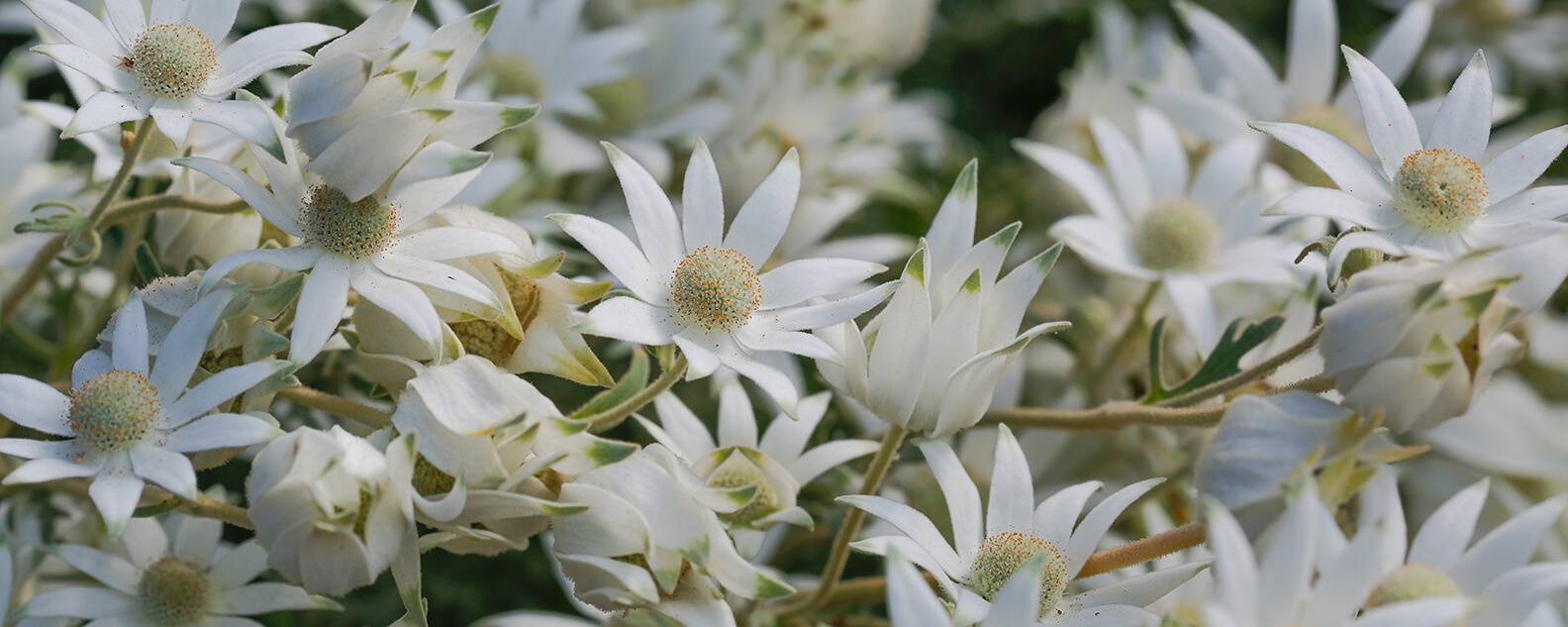Growing Flannel Flowers
Celebrate Australia's unique flora and plant the much-loved Flannel Flower in your home garden.

General planting and care
Actinotus helianthi, commonly known as Flannel Flowers, are shallow-rooted plants that require good drainage.
They have relatively brittle stems and require protection from strong winds to avoid branch breakage. They are gross feeders and have relatively high fertiliser requirements to help maintain vigour and respond well to tip pruning after the flowering period.
Older leaves on lower areas of the stems will naturally yellow and then die off while they stay attached to the plant. They can be removed for aesthetic reasons during the cooler months of the year.
Flannel Flowers can be grown in full sun or partial shade and tolerate light frost once established.
Planting conditions
For best results when field growing Flannel Flowers, we recommend a pre-prepared well-drained site of moderately acid soil with a pH of 5.5 to 6.5. This is achieved by creating a raised garden bed filled with low-phosphorus organic compost and coarse sand or native planting mix. The addition of a native fertiliser is desirable.
Some Actinotus helianthi varieties, like ‘Starbright’, make great potted plants and you’ll get the most out of them by using any commercially available premium-grade potting mix suitable for natives.
Transplanting
All species of Actinotus are particularly sensitive to root disturbance and this should be avoided during the transplantation process. When planting, we recommended spacing from 0.5 to 1.0 m.
Irrigation
If watering is required, avoid wetting the foliage to minimise damage to the brittle stems and the possible introduction of fungal problems. While they can withstand long periods of dry warm months, a tell-tale sign of water stress can be recognised by the leaves closing or clasping the stem prior to wilting.
Fertiliser
Surprisingly, Flannel Flowers respond well to regular applications of fertiliser. For best results, we suggest an application of a low phosphorous controlled release fertiliser with micronutrients during planting. Supplemental applications of a complete liquid fertiliser at monthly intervals during the growing season will assist with plant health and vigour.
Mulching
While mulching is not essential for good growth in Flannel Flowers, we suggest an organic mulch to a depth of 100 mm assists with moisture retention, weed suppression and temperature control in the root zone. Avoid contact with stems to minimise possible fungal problems.
Pruning
Light pruning after flowering is recommended to help create a bushier plant with increased flowering sites for the following season. Take care when pruning too far back into the ‘woody’ stems, as they do not reshoot. This can be followed by tip pruning in late summer if necessary.
Pests and diseases
Plants in well-structured soils that can develop good root systems are less susceptible to the soil-borne fungi, Fusarium. Avoid planting out root-bound plants and minimise root disturbance after planting.
Flannel Flowers are quite susceptible to Botrytis fungus during moist weather and should be monitored and treated with appropriate fungicide, if necessary. Fungal problems can be minimised by avoiding foliage wetting during irrigation and by periodically removing dead leaves from lower areas of the stems to improve air circulation.
Flannel Flowers may also be affected by leaf-chewing caterpillars. Monitoring plants for evidence of insect frass should be carried out to avoid major pest infestation. Aphids, scale insects and mealy bugs can also become a problem in crowded situations.
Learn more about Flannel Flowers
Offord, C.A. and Tyler, J.L. (1996). Flannel Flowers. In Horticulture of Australian Plants, (Eds M. Burchett and K. Johnston). pp. 212-217. (UNSW Press: Sydney).
Flannel Flowers are ideal for container gardening!
Visit your nearest Growing Friends in the Royal Botanic Garden Sydney, the Australian Botanic Garden Mount Annan or the Blue Mountains Botanic Garden Mount Tomah and talk to one of our plant-savvy volunteers about growing the Actinotus helianthi 'Starbright' Flannel Flower in your garden at home.